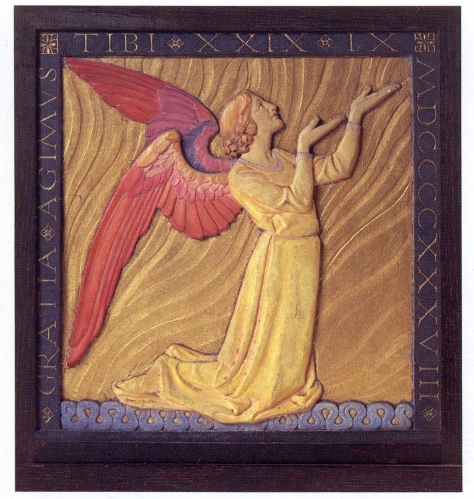By Frances Casey, Project Manager
Seventy four years ago this week, at 11.15 a.m. on 3rd September 1939, the Prime Minister Neville Chamberlain broadcast a statement to the nation which announced that Britain was at war with Germany. At the War Memorials Archive we have recorded 23,551 memorials in the UK which commemorate the Second World War of 1939-45, and 880 more memorials which are specifically to civilians of that war.
Amongst those that we have recorded, there is one memorial which is unlike any other: ‘The Angel of Peace’, a plaster bas-relief of a kneeling angel, gives thanks for the peace achieved by Chamberlain as a result of his visit to Munich in 1938 and also refers to the birth of his grand-daughter.
A typed label attached to the reverse of the memorial reads: ‘A Thankoffering made by Miss Agatha Walker under the inspiration of the visit of the Prime Minister (Mr. Neville Chamberlain) to Munich in September 1938. Given to Mrs. Carnegie* for his grand-daughter Anne Mary Lloyd born in that month’
Chamberlain’s visit to Munich in September of 1938 resulted in the Munich Agreement whereby parts of Czechoslovakia were annexed by Germany, an act that Chamberlain believed would satisfy Germany’s desires for territorial expansion. The agreement has since been seen as an act of appeasement. However, in his declaration of war made a year later, following Germany’s invasion of Poland, Chamberlain expressed his personal disappointment that his efforts for peace had failed:
‘You can imagine what a bitter blow it is to me that all my long struggle to win peace has failed. Yet I cannot believe that there is anything more or anything different that I could have done and that would have been more successful.’
As a memorial to Neville Chamberlain’s peacemaking, the Angel of Peace is the earliest memorial we have recorded that can be associated with the Second World War. It is also a memorial to a hope of peace that was short-lived, as well as a personal family celebration of the birth of Chamberlain’s grand-daughter. Agatha Walker was a sculptor and pottery figure artist, and the likelihood is that she made the tablet herself.
*Mrs Carnegie was Neville Chamberlain’s step-mother












